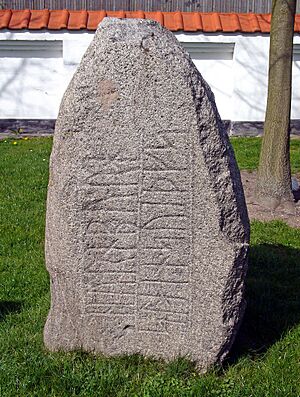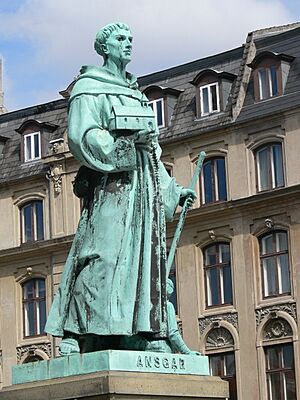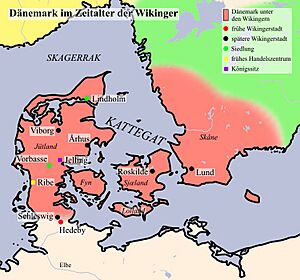History of Christianity in Denmark facts for kids
The history of Christianity in Denmark began a long time ago. One of the first attempts to bring Christianity to the Danes was by Saint Willibrord in the early 700s, but it wasn't successful at first.
Contents
Old Pagan Beliefs
Before Christianity, the Danes believed in the gods of Norse religion. We know this from runestones (stones with ancient writings), old place names, and names people used to have. Thor was a very popular god; his name was still used even after people became Christian. The city of Odense might even be named after Odin, suggesting it was a place where he was worshipped. Some runestones also mention people named after Freyr. Even a lake, Tissø, is likely named after the god Týr. Archaeologists even found what they think was an old pagan temple near Lake Tissø.
Stories about Thor, Odin, and other gods can be found in Icelandic sagas and a book called Prose Edda by Snorri Sturluson. These books tell us a lot about their myths and how they were worshipped. However, we can't be sure that the beliefs and practices in Denmark were exactly the same as in Iceland. Also, some old Christian writers like Adam of Bremen and Saxo Grammaticus wrote about the pagan Danes. We need to be careful with their stories because they sometimes made non-Christians sound bad.
How Christianity Arrived
People in Scandinavia started learning about Christianity even before the fall of the Roman Empire. But historian Ian N. Wood says that bringing Christianity to Scandinavia was like exploring new lands for the Church.
In the early 700s, a monk named Willibrord tried to convert Ongendus, the King of the Danes, but he didn't succeed. Later, in the 820s, the Frankish kings (from what is now France and Germany) tried to get more power in Denmark. King Harald Klak was forced out of Denmark. He found safety with the Franks and agreed to be baptized in 826.
Harald Klak went back to Denmark with Ansgar, a Frankish monk. For the next two years, Ansgar worked to spread Christianity in Denmark. He even bought young boys to teach them to become missionaries. But Harald Klak was again removed from power in 827, and Ansgar had to leave Denmark.
The Diocese of Hamburg became a key place for missions to nearby people, including the Danes. Ansgar became the first bishop of Hamburg in 831. He even went to Rome in 840 to receive a special symbol of his new rank as archbishop. He visited Denmark again and bought more boys to educate them for missionary work.
In 845, Viking raiders destroyed Hamburg. Ansgar then became the bishop of Bremen. This caused some arguments with the archbishops of Cologne, who thought Bremen was part of their area. Ansgar worked closely with Kings Horik I and II and kept up his missionary efforts in Denmark. Even though both kings remained pagan, Horik II allowed Ansgar to build a church in Ribe and sent gifts to Pope Nicholas I in 864. After Ansgar died in 865, his work was continued by his successor, Rimbert.
About a century later, a writer named Widukind of Corvey said that "the Danes had long been Christians but they nevertheless worshiped idols with pagan rituals." This suggests that many Danes might have worshipped the Christian God without thinking he was the only god. Changes in how people were buried, like burying bodies instead of burning them and placing graves from west to east, started in the late 800s. This might show Christian influence, but we haven't found any clear Christian objects from that time. In the 900s, some burial mounds with many valuable items show that old pagan burial customs returned.
In 948, three German priests became bishops for three Danish areas: Liafdag for Schleswig, Hored for Ribe, and Reginbrand for Aarhus. This was probably to make the Archbishopric of Hamburg-Bremen stronger. There's no clear record that these bishops actually visited Denmark before the country officially became Christian.
The Middle Ages
Denmark Becomes Christian
Denmark officially became Christian during the time of King Harald Bluetooth, who became king around 958. A writer from that time, Widukind of Corvey, tells a story about a priest named Poppo. Around 965, Poppo supposedly convinced Harald that "there is only one true God" and that pagan gods were "in truth demons." Poppo did this by carrying a large piece of glowing hot iron in his hand without getting hurt! After this, Harald quickly told his people to stop worshipping pagan gods and become Christian.
Another writer, Adam of Bremen, said that the Holy Roman Emperor, Otto I, defeated Harald and that's why Denmark converted. However, historian Michael H. Gelting says Adam's story isn't very reliable. Still, Harald was trying to improve his relationship with the Holy Roman Empire in the early 960s, which likely helped him decide to convert.
Setting up the Church
In 965, Emperor Otto I gave special rights to the bishoprics (areas led by bishops) of Schleswig, Ribe, and Aarhus. He also confirmed that Adaldag, the Archbishop of Hamburg-Bremen, was in charge of these three bishops. A few years later, a fourth bishopric was started in Odense.
After Harald Bluetooth was removed from power by his son, Sven Forkbeard, around 987, the four bishops fled to the Holy Roman Empire. Adam of Bremen said that Sven's rebellion was "a conspiracy to renounce Christianity," meaning to give up Christianity. But no other sources confirm that paganism was brought back in Denmark after Harald's fall.
By the end of the 900s, pagan burial customs mostly disappeared. In the eastern parts of Denmark, they disappeared in the early 1000s. Instead of bishops who reported to Hamburg-Bremen, Sven Forkbeard supported missionary bishops from England. These bishops didn't have permanent church areas. Adam of Bremen also said that missionaries from Hamburg-Bremen worked in Denmark during this time, but he only named Odinkar the Elder, who was related to the king.




